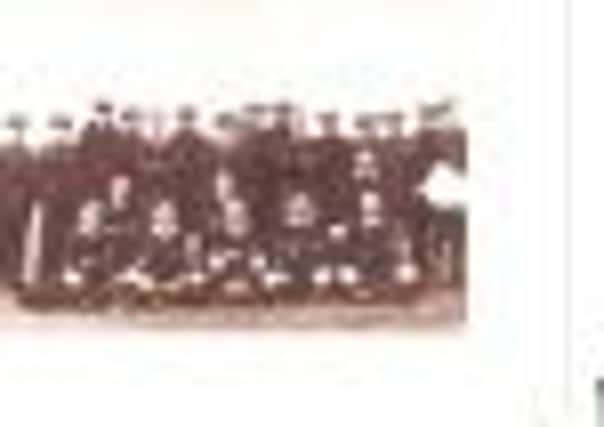County’s soldiers killed on Easter Monday 1917


The facts are supplied by Leamington historian David Eason.
The battery was raised in 1908 as part of the county’s contribution to the newly-formed National Territorial Force, commanded by Lord Brooke, the son and heir of the Earl of Warwick. They were based at Warwick Castle where they used the stables (the present cafe), the gun house (present ticket office), the hay loft (present offices) and the Shakespeare Room for an office and stores.
The battery stayed at the castle until 1911 when the War Office purchased No 9 Clarendon Place, Leamington, as its HQ, where signs still remain in the area of the present Cadet Hut.
Advertisement
Hide AdAdvertisement
Hide AdAt midnight on Tuesday August 4, 1914, as war was declared, the battery was mobilised and re-designated as the 1st/1st Warwickshire Royal Horse Artillery Battery.
The following day every member of the 1st/1st had turned in and, after nine days of frantic preparation, mustered at the Midland Oak Park, near Lillington, where their memorial stone cairn is now located. Then on August 14, after the guns, horses and troops had camped on Northumberland Road, Leamington, the night before, they rode down to Leamington train station bound for Bury St Edmunds before eventually disembarking on November 1 at Le Havre. The 1st/1st Battery was the first British Territorial Unit to arrive in France.
During the years of bloody battles which followed many of the battery’s soldiers were killed, with particularly heavy losses suffered on Easter Monday, April 9, 1917.
On that day the 1st/1st Battery was in action at St Sauveur during the joint offensive by the First and Third Armies in the Vimy-Arras sector.
Advertisement
Hide AdAdvertisement
Hide AdThe plan was to thrust forward taking Vimy Ridge (where the Germans had for long held the French at bay) and south east towards Cambria and then hopefully further.
By April 7 the Germans had suddenly and without prior warning withdrawn their defensive line back to the Hindenburg Line. Their new positions were now sited on a reverse slope south east of Arras, denying the British any chance of observing them.
After changing the plans, the Allied offensive began early morning on Easter Monday, a day of sleet and snow in which the battery would give fire support on to three objectives.
It was during this battle that the battery was targeted by a heavy counter-battery fire barrage which killed many men, including: Acting Bombardier Frank Oliver Cope, 23, of Park Street, Leamington; Bombardier John Eton, 33, of Leamington; and
Corporal George Ernest Edmunds, 22, of Cape Locks, Warwick.
Advertisement
Hide AdAdvertisement
Hide AdSeveral were wounded and two local men died of their wounds shortly afterwards: Staff Sergeant (sadler) Harry Winyard, 34, of Bedford Street, Leamington and Gunner Reginald Ernest Robinson, 23, of Church Street, Leamington.
Back home, another battery had been formed in Leamington in 1915, the 2nd/1st Warwickshire Royal Horse Artillery Battery (under Major, The Marquis of Ivrea). After being fully trained she followed her sister to France on June 21, 1917. This battery saw action on Friday July 20, 1917 during which two Leamington brothers were killed in action; Gunner Albert Edward Smith, 25, and shoeing smith Sidney George Smith, 30. Both Albert and Sidney are buried at the Vlamertinghe New Military Cemetery, West-Vlaanderen, Belgium.
One of their fellow soldiers in the 2nd/1st Battery was driver Charles Corley who survived the war. His son Tony, of Rugby Road, Cubbington, has supplied this extract from his father’s diary: “I enlisted in the RHA on May 7, 1915, aged 17, and was fitted with a uniform at Warwick Cloth Hall. After training on Salisbury Plain in Wiltshire, we sailed from Folkstone to Boulougne to relieve another battery. We saw service in France, Belgium and Germany on the Rhine. We followed the Hun back to Cologne until the Armistice arrived November 11, 1918. I came back home the following May (1919) for demob, four weeks leave thrown in.”
Tony has supplied a photo of his father in uniform and a photo of the 2nd/1st’s football team and 14 other members of the battery (taken in Wiltshire before they left for France).
Advertisement
Hide AdAdvertisement
Hide AdThe team photograph may be of interest to other local descendants of soldiers. If anyone can identify people in the photograph, please contact Nostalgia editor Peter Gawthorpe on 01926 457732 or email [email protected]
A third Warwickshire RHA battery was formed but remained at home in Leamington, training and supplying replacements for the two serving batteries. All three batteries were disbanded in 1919.